Meet the Women Behind Charlotte’s Landscape
Published on March 14, 2024
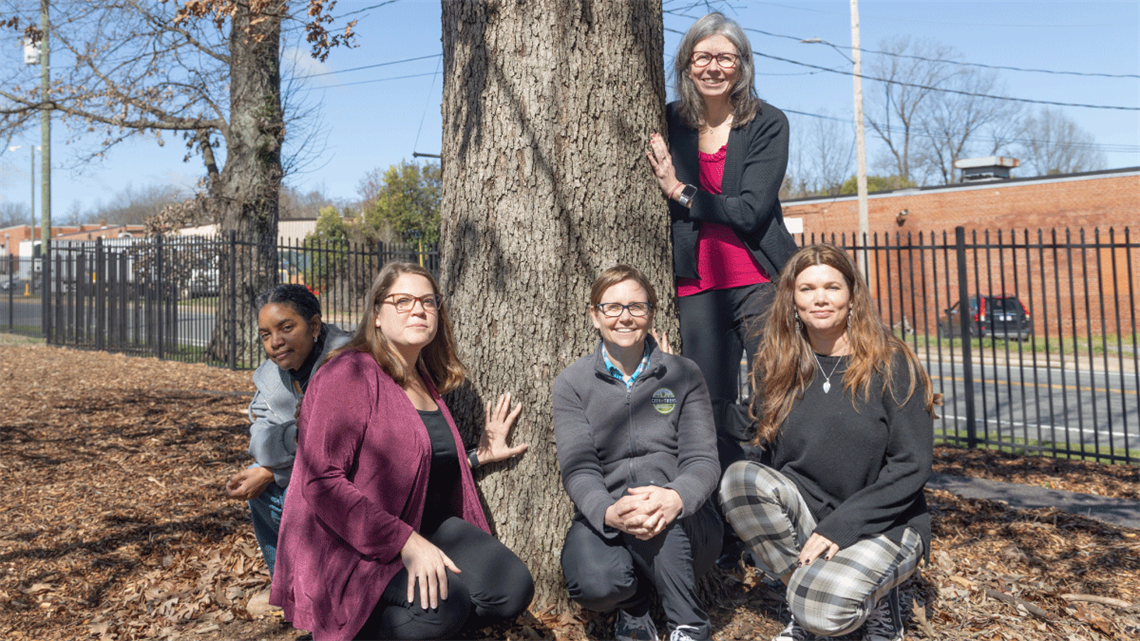
Left to right: Natasha Warren, Kourtnie Vincent, Laurie Reid, Erin Oliverio (standing), and Victoria Aguilar.
Subscribe to the City Speaks newsletter to receive important local government stories, like this one, in your inbox biweekly.
By Kayla Chadwick-Schultz
The first thing I noticed after parking outside of the City of Charlotte’s Landscape Management offices off Tuckaseegee Road was the landscaping. Seems obvious, I know, but there was something so unique about it. It was creative and bright and diverse. I found myself wanting to learn more, but I wasn’t actually there to talk about landscaping—not entirely, anyway. I was there for Women’s History Month.
Now, the world of landscaping has not always been a woman’s domain. Historically, it has positioned men as its primary participants. Men knew the science, men did the math, and men performed the manual labor. It was a man’s world, but when I looked out across the large conference room table on the first floor of the Landscape Management offices, all I saw were women. Five women, to be exact: Landscape Management Division Manager Erin Oliverio, City Arborist Laurie Reid, Assistant City Arborist Victoria Aguilar, City Arborist Group Program Manger Natasha Warren, and Capital Investment Plan (CIP) Program Manager Kourtnie Vincent.
While these five women do not make up the entirety of the Landscape Management division, they are all essential members of its workforce with important stories to share about being women in a field so often dominated by men.
The City of Charlotte’s Landscape Management Division
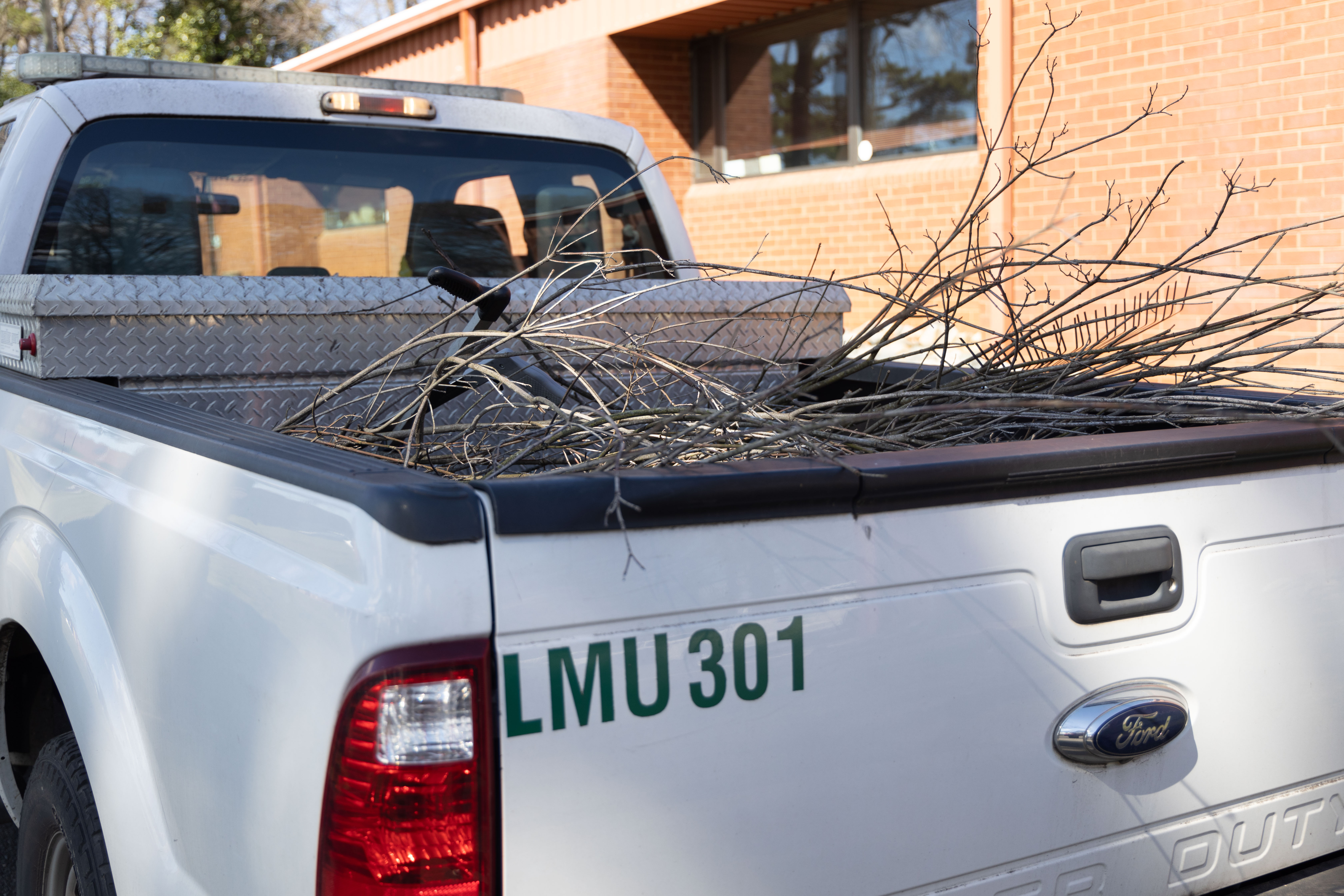
Landscape Management truck filled with branches.
Before we jump into those stories we should probably talk a little bit about what the City of Charlotte’s Landscape Management division is and does.
This division is part of our General Services department, which is among the most diverse departments in the entire City of Charlotte organization. It employs around 400 people and delivers a broad set of services to the residents of Charlotte and other municipal agencies. The goal of General Services is to help build a better community for everyone who lives and works in Charlotte. So, naturally, maintaining the city’s landscape and renowned tree canopy would fall under the mission of building a better community.
Here's how they do it. The Landscape Management division is responsible for planning, designing, operating, and maintaining city-owned green spaces and vegetation. It is made up of four distinct teams: Capital Investment Plan (CIP), Cemeteries, Landscape Operations, and Tree Management.
The CIP team reviews plans for the City of Charlotte’s CIP Projects and suggests appropriate measures to protect and sustain the tree canopy through construction. It designs and installs creative, sustainable landscapes using appropriate plant material and green industry best management practices.
The Cemetery team perpetually cares for seven city-owned cemeteries, which totals 200 acres of landscape maintenance.
Landscape Operations maintains more than 1,500 acres of landscaping across more than 200 city properties, including designated facilities, vacant parcels, nearly 1,000 medians, and six public spaces (Arequipa Park, Crescent Park, Five Points Public Plaza, The Green at Prosperity Village, The Ritz at Washington Heights, and McColl Park). The Mecklenburg County Park & Recreation department is responsible for all other parks within Charlotte’s city limits.
The Tree Management team protects, maintains, and grows the city’s famed tree canopy. It also dedicates time and resources to providing residents with valuable tree care resources and education. It plays a significant role in Charlotte retaining its nickname as the City of Trees year in and year out.
Now, this is far from a sweeping overview of what the Landscape Management division does on a day-to-day basis. Truthfully, I could spend an entire article just talking about how beneficial this group is to our city, but that’s not what this article is about. This article is about five women, their experiences, their struggles, and ultimately, their triumphs.
The Ups and Downs of Being a Woman in Landscaping
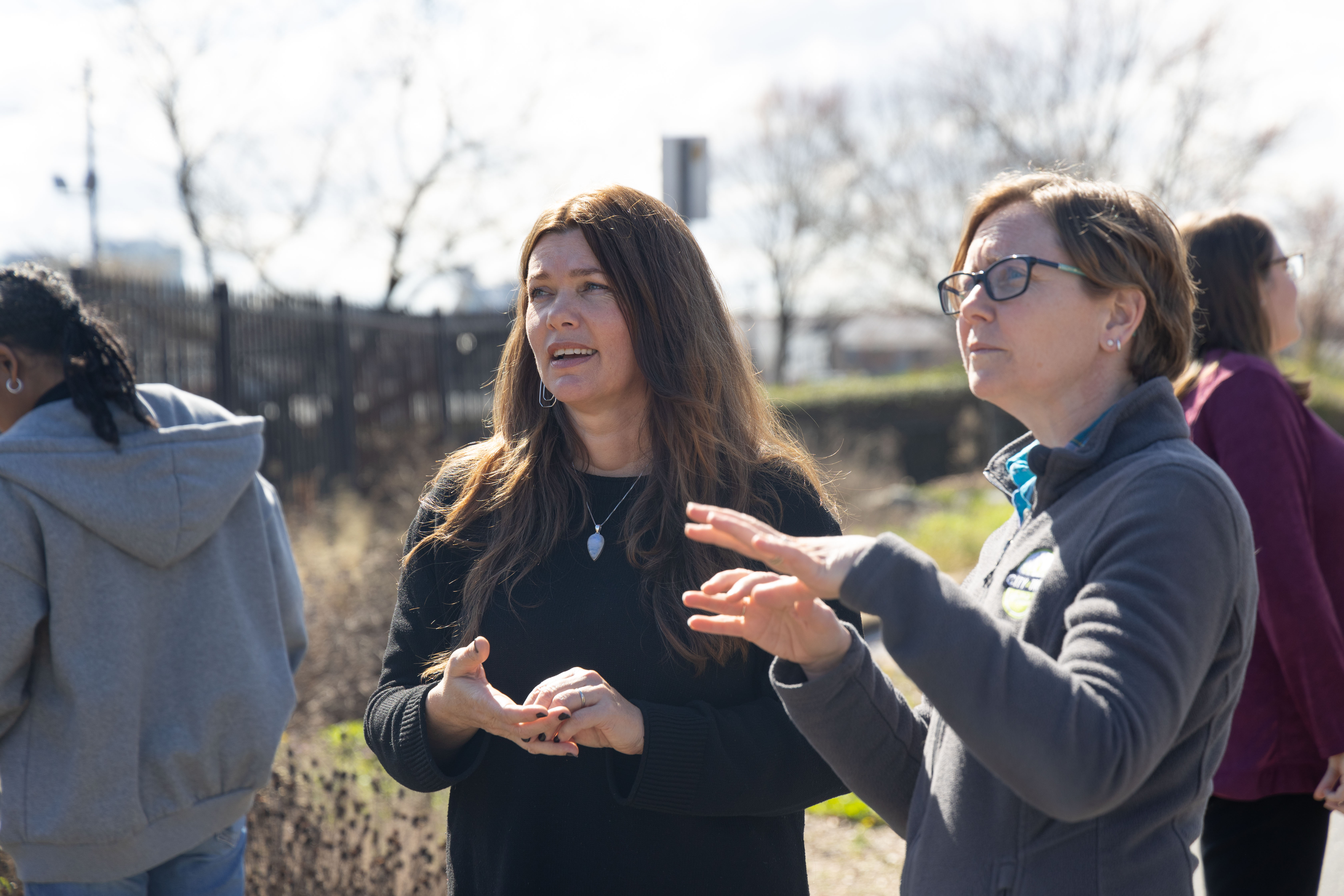
Victoria Aguilar (left) and Laurie Reid (right) talk through options for maintaining a tree on the property.
When Natasha Warren began her journey into this line of work, there was a clear and obvious lack of diversity.
“When I looked around the room, there were usually very few women,” she explained, in reference to her education at NC State University in the 1990s. “And I can’t remember a single other Black person that was there, in any of my classes that were specifically related to the green industry.”
Warren first joined the City of Charlotte’s Landscape Management team in 1998. At the time, there were only two other women in the entire building, and both held administrative roles—"one handled budget and one handled human resources.” She recalled having to share space with the rowdy tree trimmers, all of whom were male. Fast forward to present day, and she can hardly believe the situation in which she now finds herself.
“I’m just in awe,” said Warren. “I look around, and I look at who I have next to me, and I look at what these women are doing, and I’m just so incredibly impressed. I just see the vision that they have and the drive, and it’s just a very, very different vibe.”
As Warren shared her story, nearly every woman in the room nodded in agreement. Their experiences, while unique to them as individuals, frequently mirrored one another…
Kourtnie Vincent was one of two women in her college program. All of her internship supervisors and teammates were men.
Laurie Reid was the only female undergraduate student in Clemson’s entomology program. She’s now the City of Charlotte’s first-ever female City Arborist.
Erin Oliverio’s role as Division Manager had been occupied exclusively by men for the last 30+ years.
“I’ve had some experiences, too, of people not wanting to hire women, because ‘they won’t fit,’” Victoria Aguilar added. “It’s hard for women just to even get their foot in the door a lot of times in a male-dominated industry like this.”
In particular, Aguilar has dealt with several instances where the men around her automatically assumed she didn’t know what she was doing. It had nothing to do with her credentials or her experience; it was simply a result of her gender. “Just, like, assuming that you don’t know how to use the equipment or don’t know how to back the trailer up,” she explained.
On the contrary, Aguilar can maneuver equipment and perform the necessary manual labor better than most, regardless of gender. Oliverio shared, “I remember one time, on a Saturday, [Aguilar] volunteered for TreesCharlotte, and we had to pull out this massive trailer—like tons of weight on the truck—and she maneuvered it through Uptown Charlotte. I was just blown away. I never questioned that [she] could or couldn’t do it, but I was just like, ‘that’s why she’s here.’ She’s skilled at what she does. It’s impressive.”
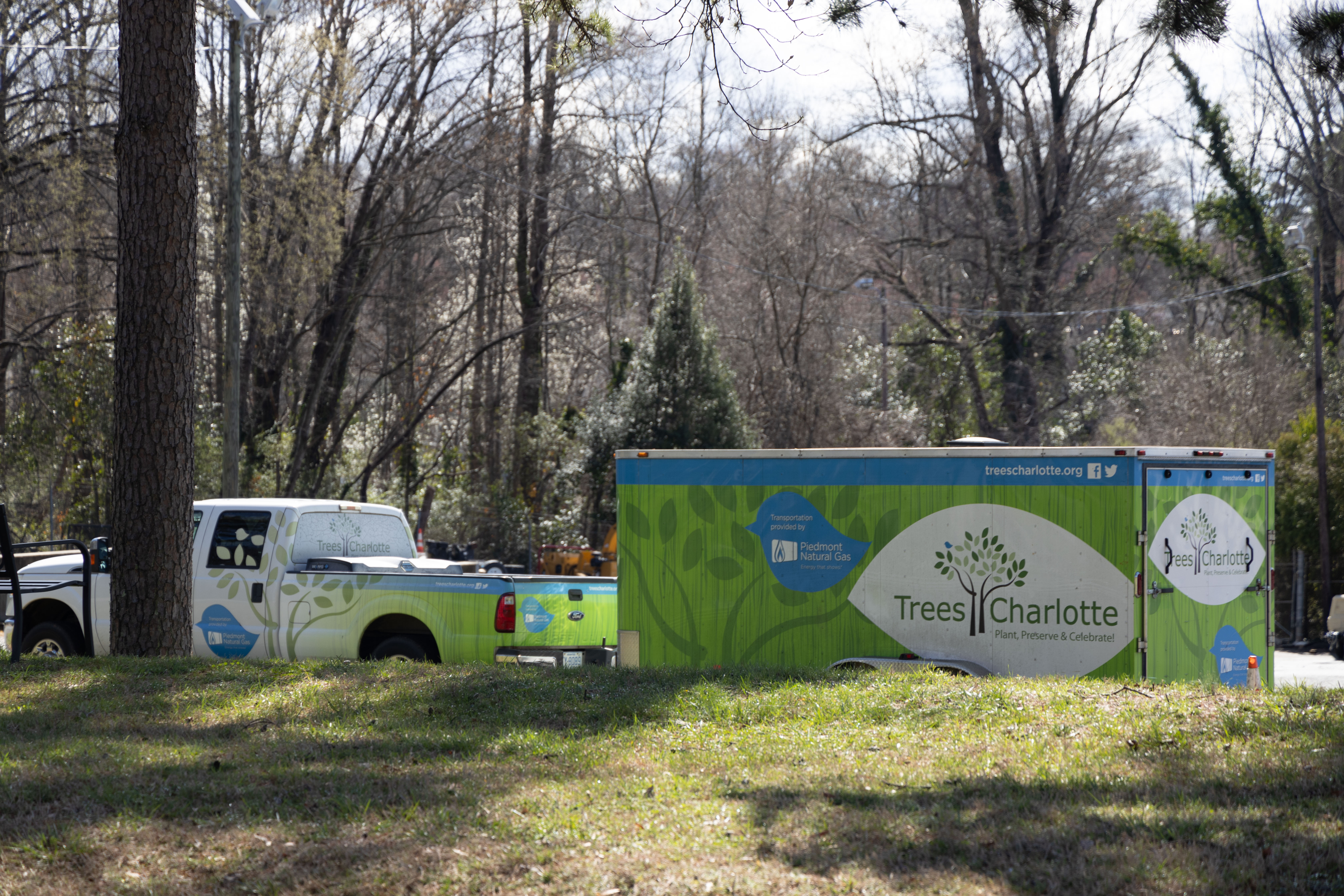
TreesCharlotte truck and attached trailer.
In fact, all five of these women are incredibly skilled at what they do. They’ve earned advanced degrees, they’ve gained years of valuable work experience, and they’ve proven themselves capable in the face of every new challenge or opportunity. Even so, they frequently deal with incorrect assumptions. Reid was once mistaken for a high school intern when meeting with a male landowner, despite having a master’s degree and being the project lead. “They don’t expect a woman to come up and talk to them about these things,” she added.
Expectation. That’s what it always seems to come back to—assumptions formed out of expectations. Oliverio recalled her supervisor not expecting her to pass her arborist certification in her first year on the job, despite having been hired for her qualifications. Low expectations of women are a truth of the landscaping industry, and they’re equally true in construction.
“It takes us longer to earn respect in the construction field,” Vincent offered. As a certified Landscape Architect and manager of the CIP team, she often works with construction contractors to bring functional, aesthetically pleasing landscape areas to life. However, that task is made all the more difficult by the assumptions placed solely on her gender. “I always feel like you have to prove yourself, you have to educate, and you have to be very on your game. You have to walk up with confidence. You have to know the material better than them, so that they’re not looking at you like, ‘oh, are you just here to take minutes?’”
Upon hearing this, Aguilar chimed in: “Yes, there’ve been many times that they thought I was the secretary and asked me if I was the secretary.”
“It’s difficult to go into that situation and be the enforcement person,” Reid added. “I’ve literally had someone, after I had to enforce something, call someone else in the city and say, ‘she’s mean.’ And, you know, would he have said that if I was a man telling him to do this?”
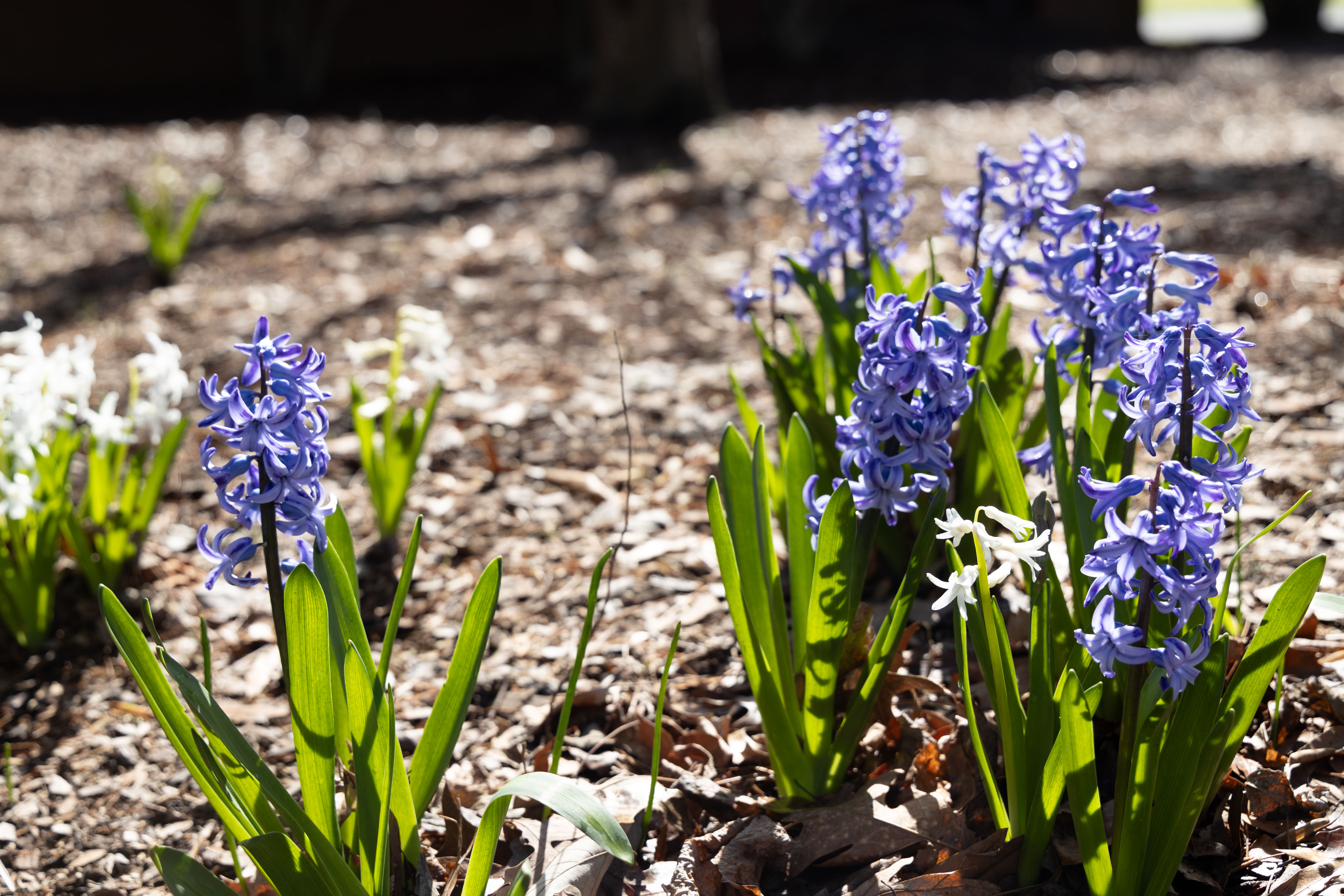
Purple hyacinths blooming in front of the Landscape Management offices.
As each woman told story after story, commiserating in their shared experiences within a male-dominated field, everyone smiled and laughed. It wasn’t funny—not at all, really—but what else can you do? How else can you share stories of unfair assumptions and offensively low expectations? Laughter is how we cope, how we connect, how we release our pent-up frustrations in a way that’s healthy and comfortable. It’s normal to laugh, but the laughter eventually faded and the emotions behind it emerged.
“It’s disappointing,” revealed Warren. “I remember having other staff just be stunned that I can even do a lot of the calculations that are required for fertilizer or understand the details of photosynthesis. It was just… It’s really sad to have to experience that.”
“It’s emotional,” Vincent added through growing tears. “I’m emotional. That’s a hard thing for me. It comes out naturally. People don’t like that. They find that negative, but that’s passion. That’s love.”
As Vincent let her emotions wash over her, Oliverio chimed in: “I think that’s what I love about this group of women and what we’re doing, because we’re pulling from everyone’s strength and what they’re passionate about. And we’re changing the narrative about landscape management. Not just from the fact that it’s more female-led now, but that people feel more open to talk about feelings and to have emotions around things. It’s okay that we love what we do. That’s where we are now.”
“It’s okay to celebrate our vulnerability, because there’s nothing wrong with it,” continued Vincent. “It makes us stronger.”
Passion, strength, love—these are the things that keep them going. This is why, despite every challenge or unfair assumption, these women keep pushing forward. They simply love what they do.
Following Their Passion: “I Just Like Being Outside”
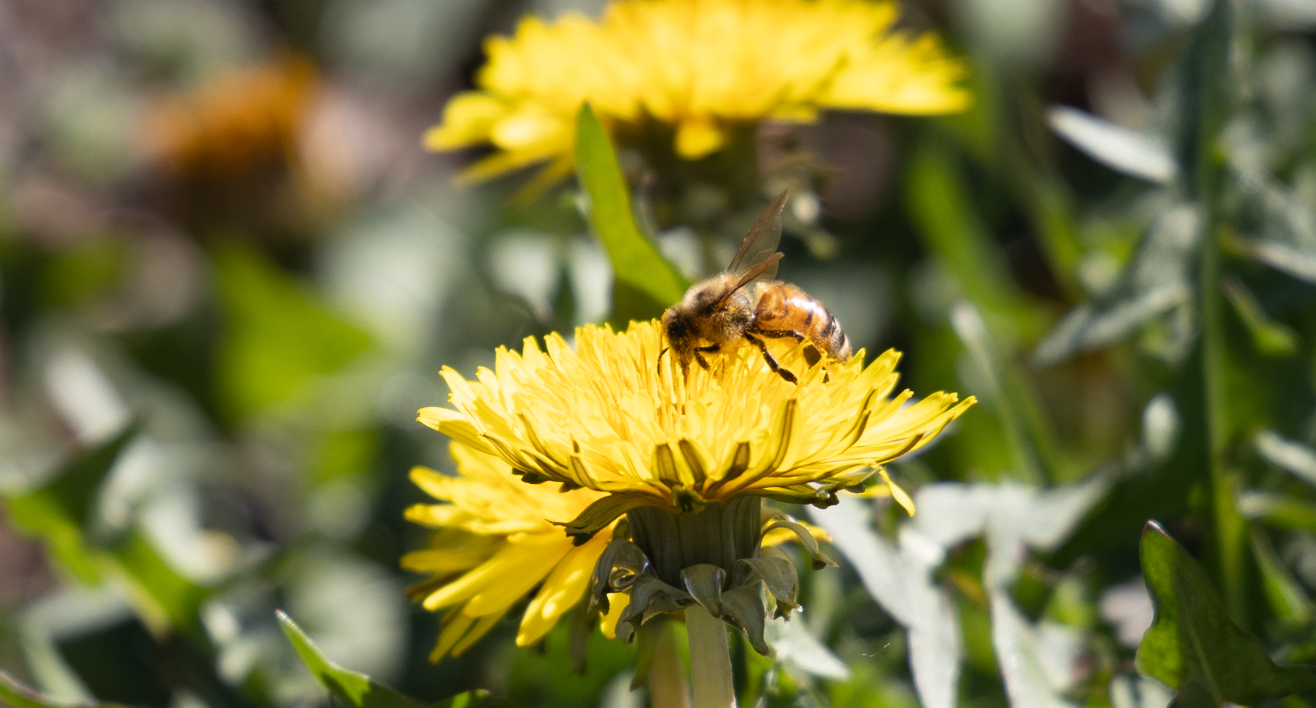
Bee visiting the Tuckaseegee Pollinator Garden.
After hearing their stories, I had to know more about what drew them to this work in the first place. It is not an easy career path for a woman, so why do it? What makes it worth it?
In a way, these are more than just jobs to each of these women; these are their callings. They all grew up loving the outdoors, watching their families farm and garden, obsessing over wildlife and all the wonders of the natural world. It feels inevitable that they would end up where they are today. Of course, even inevitabilities take a lot of hard work, but the question of whether or not it was worth it never really occurred to them. It was just what they were meant to do.
Reid loved being outside, loved trees, and loved bugs. So, naturally, she studied entomology and forestry. “For me, I just kind of followed my passion—what I love to do,” she noted.
“I was probably the same,” added Vincent. “My mother was an herbalist. My grandfather was a naturalist and a farmer. Everybody was a farmer. It was survival. So, being outside, growing things, animal caretaking—it’s everything I know.” In addition to being raised on a farm and having a genuine appreciation for the work, Vincent also had a creative brain and loved design, so she studied landscape architecture. “It basically took everything I loved and put it into one.”
Warren had a similar upbringing in rural Indiana, where the neighbor’s rooster crowed like clockwork every morning and everyone grew their own vegetables. Originally, she attended NC State University to study engineering, but she quickly developed a distaste for it. Instead, she pivoted back to her farmland roots. “You could call it coincidence, but I think there’s something sort of magical about it too. The fact that it sort of draws you,” Warren explained. “You sort of land where you started, so to speak. I have a lot of comfort in this space.”
“Personally, for me, I just like being outside and I love plants,” Aguilar contributed. Her grandmother was an avid gardener and taught her about vegetable gardening at a young age. “I don’t think there was ever another option for me,” she claimed. “You know? I just wanted to work outside.”
I had no reason to believe that any of them were lying about their passion for the great outdoors. In truth, I had no doubts that their love for all things nature was genuine. However, when I finally stepped outside with all five women and began a tour of the facility’s landscaping, they still managed to surprise me with just how completely and unabashedly they love the outdoors.
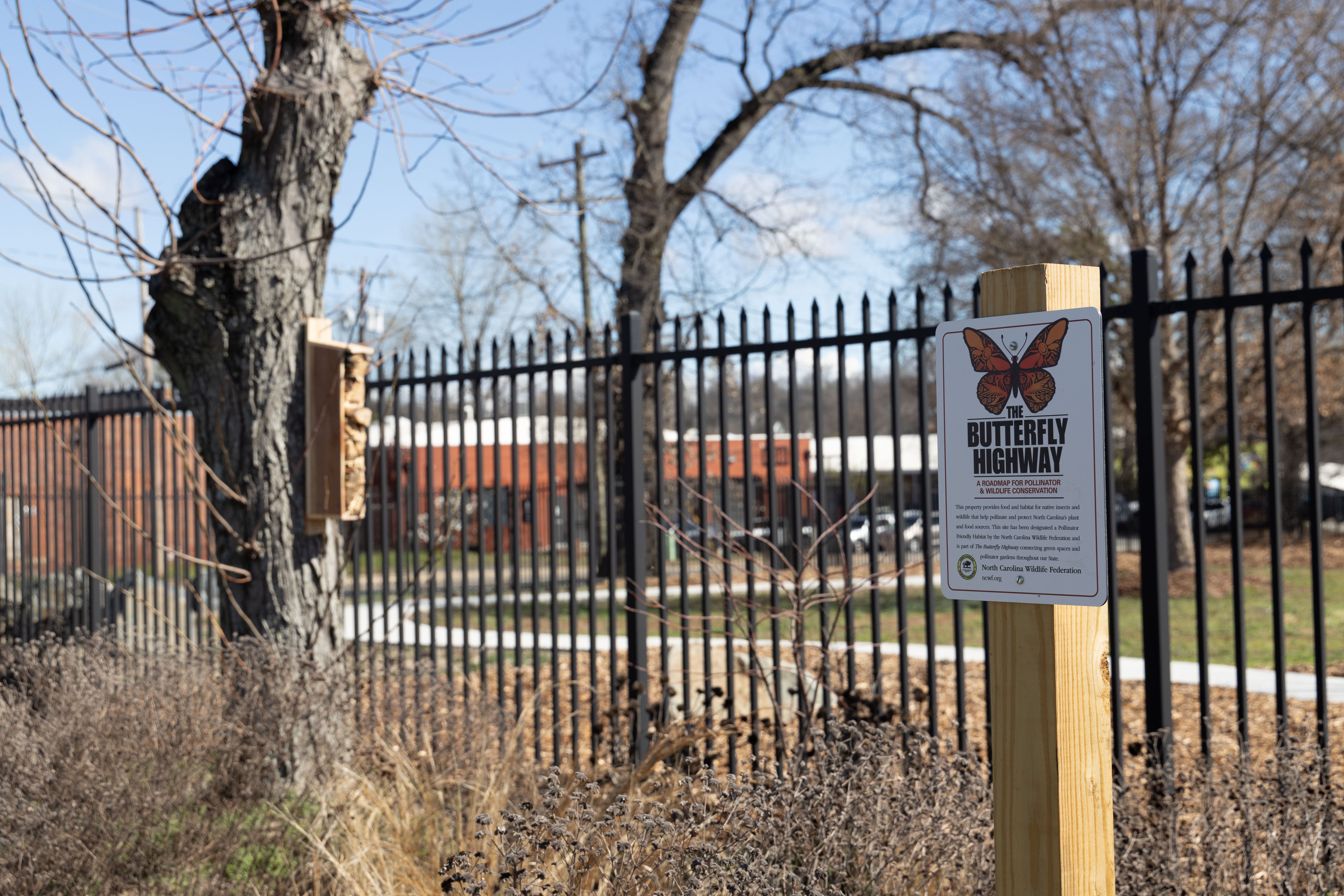
Sign identifying the Tuckaseegee Pollinator Garden as part of N.C.’s Butterfly Highway.
First, I asked Reid which tree was her favorite. She named one, but then quickly admitted they’re all her favorites for different reasons. As we made our way to her favorite tree (at that current moment), I learned about the mulch, the leaf prints in the pavement, the newly planted flowers, the flowers that were sprouting, the flowers that were blooming, and the bugs that they frequently see outside their offices. Mind you, the walk to Reid’s favorite tree took no more than 40 seconds. As it turns out, you can learn a lot about a landscape in 40 seconds when you’re surrounded by people who genuinely love it.
After we took some photos at the tree, we visited the roadside pollinator garden, which Oliverio and Aguilar like to think of as a test garden where they can see what works and what doesn’t before implementing it across the city. There, they showed me the new “bee hotel” that Aguilar set up. I stopped to take some photos of the various flowers, the bees that frequented them, and whatever else caught my eye. All the while, Reid and Aguilar jumped into work mode—discussing what they should do to fortify the tree on which the bee hotel hung. They didn’t have to suddenly start working; they just did. It’s what they do.
My tour of the grounds ended with a trip around the back to hopefully catch a glimpse of the horned owls that were nesting high in a pine tree. Everyone was excited about the possibility of showing me, but they weren’t positive we’d be able to see them. Luckily, the owls were up in the nest, and we were able to see the slight rustling of feathers from a long distance. I snapped a photo, unsure if I was actually capturing anything or just a bundle of twigs high up in a tree.
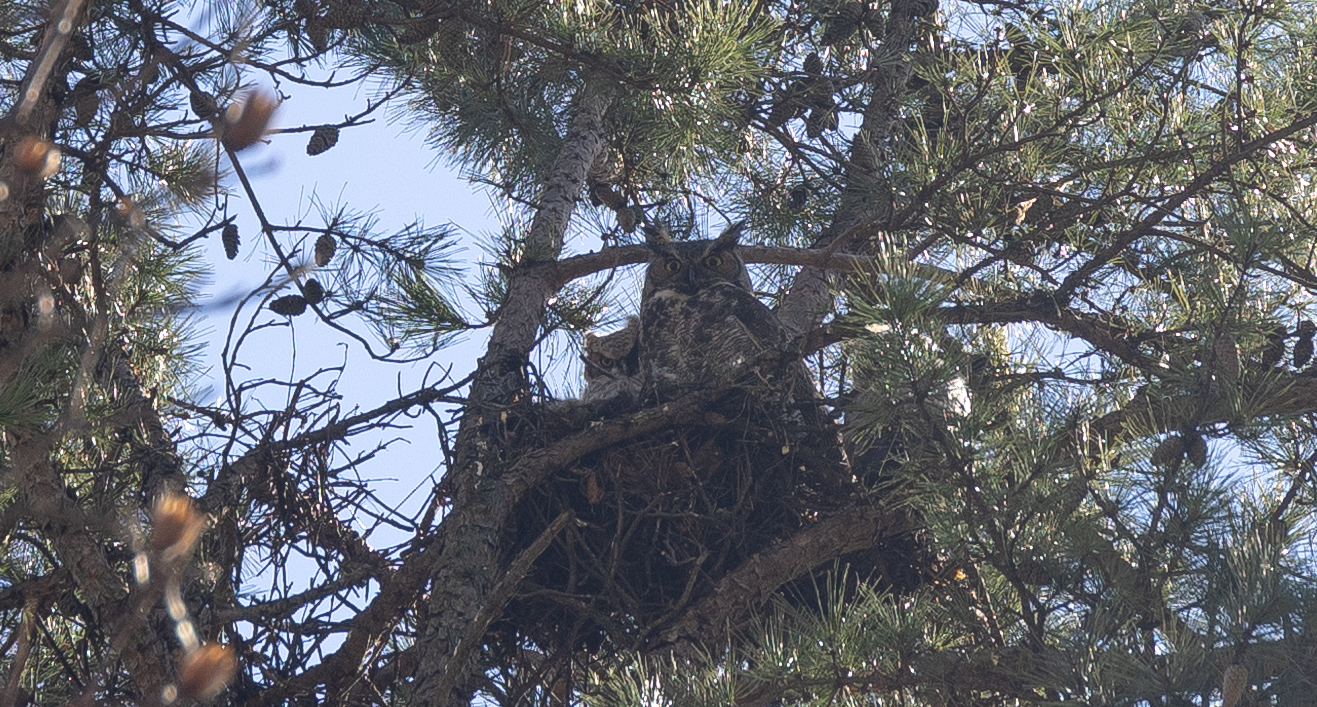
Two horned owls nesting in a pine tree on the Landscape Management building grounds.
When I got back to my office and processed the photos, I was just as excited as they had been to discover two beautiful owls looking down at us. I immediately emailed it to them, and my inbox was promptly flooded with exclamation marks and enthusiasm.
Again, I never once questioned their passion, but it is truly something to behold. Being out in nature with these five women is a legitimate privilege. It’s enough to convince any homebody to spend a day digging in the dirt. In fact, you can during one of Landscape Management’s many volunteer events (search keywords such as “trees” and “landscape” to filter events).
I highly encourage anyone interested to attend one of these events and get to know these remarkable women. Their passion is undeniable and their commitment to their work is astonishing. They embody what it is to be successful, capable women in a male-dominated industry and to continuously persevere in the face of adversity. I left the Landscape Management offices inspired by the words and wisdom of these five women, and I hope you feel the same after reading this. Happy Women’s History Month, Charlotte. Keep doing what you love.